#darci kistler
Explore tagged Tumblr posts
Text
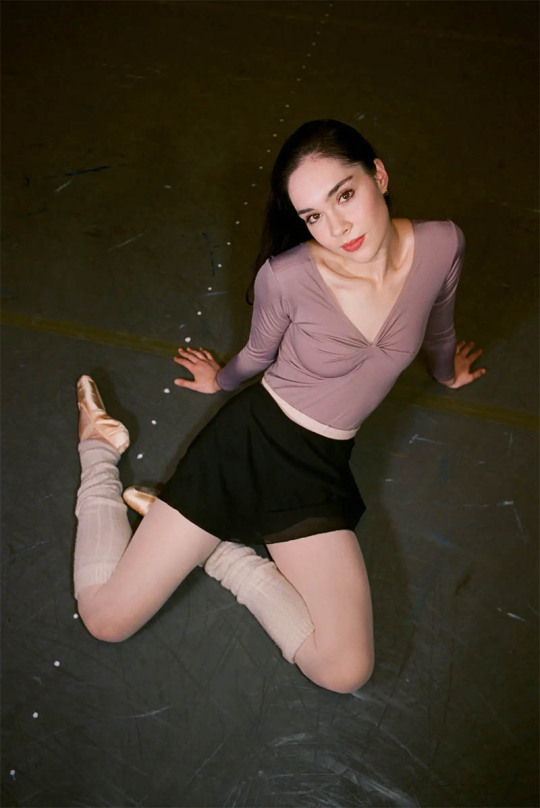
At City Ballet, a Once-in-a-Generation Dancer Arrives
Mira Nadon, the rising New York City Ballet principal, is coming off her best season yet. And it’s only the beginning. By Gia Kourlas The New York Times May 29, 2024
Mira Nadon was 5 when she took her first ballet class. It was pre-ballet, which meant running around the studio, maybe getting a shot at fluttering like a butterfly. This was not for her.
When she found out that students began proper training at 6, Nadon laid it on the line: “I told my mom, ‘This isn’t serious,’” she said. “‘I’m just going to wait till I’m 6.’”
Even then Nadon was levelheaded and unflappable. Now, at just 23, she is a principal dancer with New York City Ballet, approaching the close of a momentous season at Lincoln Center, where her versatility, artistry and jaw-dropping abandon have made her seem like a ballerina superhero. This week, she returns to the role of Helena, the rejected young woman determined to win her lover back in George Balanchine’s “A Midsummer Night’s Dream.” An affinity for drama is in her bones, but something else makes Nadon a rarity: humor.
Nadon, the first Asian American female principal dancer at City Ballet, is a special, once-in-a-generation kind of dancer. Nadon can flip among many sides of herself—secretive, seductive, funny, serene. And she lives on the edge, with rapid shifts from romantic elegance to ferocious force. A principal since 2023, Nadon still has raw moments, but so much is starting to click: Her feet are more precise, her partnering more secure.
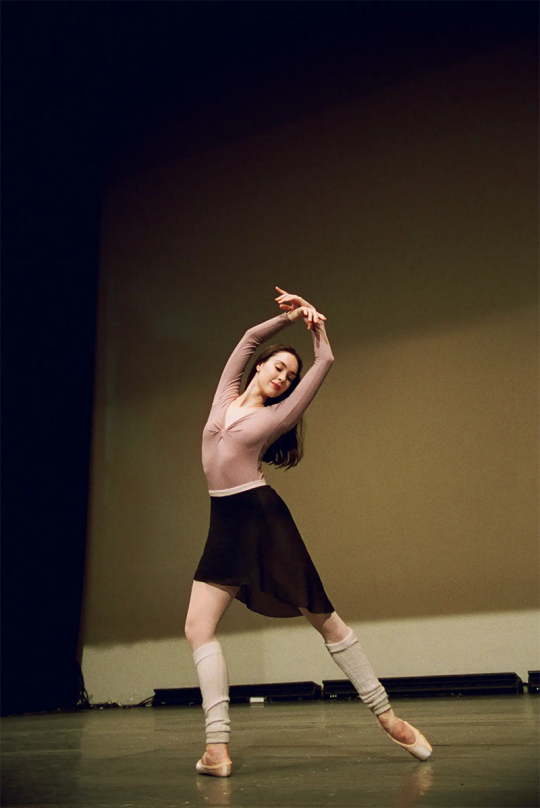
This photo and the one at the top: Sabrina Santiago for The New York Times
“To watch her grow — and it’s not been very long—has been tremendous,” Wendy Whelan, the company’s associate artistic director, said. “It’s fast and big and just blossoming.”
This spring season, the close of the company’s 75th anniversary year, has been largely dedicated to newer ballets. She has danced in works by living choreographers, including Alexei Ratmansky and Pam Tanowitz, and made debuts in works by George Balanchine and Jerome Robbins. “The range has been astounding,” Whelan said. “She’s been able to hone in on the uniqueness of each of those voices. And she cares about what the intent is of each of those voices, so they’re not all the same. She doesn’t just go out and do great things. She actually carves out the idea.”
The most important debut was in “Errante” (1975), a Balanchine ballet originally called “Tzigane” after its score by Maurice Ravel. Suzanne Farrell, for whom the ballet was made, staged it and coached Nadon. “She’s such an intelligent woman and so dry and funny in the best way in the studio,” Nadon said. “She’s very, very demanding. She’s not just going to say ‘good job’ because you tried and you’re working hard. But I love that.”
The ballet opens with a five-minute solo for Nadon, whose smoldering use of her eyes and face, along with the smooth control of her body, showed a deep command of the stage as she wound her way along its mysterious violin solo. Farrell told her that the solo was a lonely experience. “I think she was excited for me to feel that onstage with the violinist,” Nadon said. Toward the end of the rehearsal process, Farrell told her that she shouldn’t move in a modern way but in a “very stylized older way,” Nadon said. “I think that’s also what makes it such a special world, that it’s unique and different from the way you approach another ballet.”
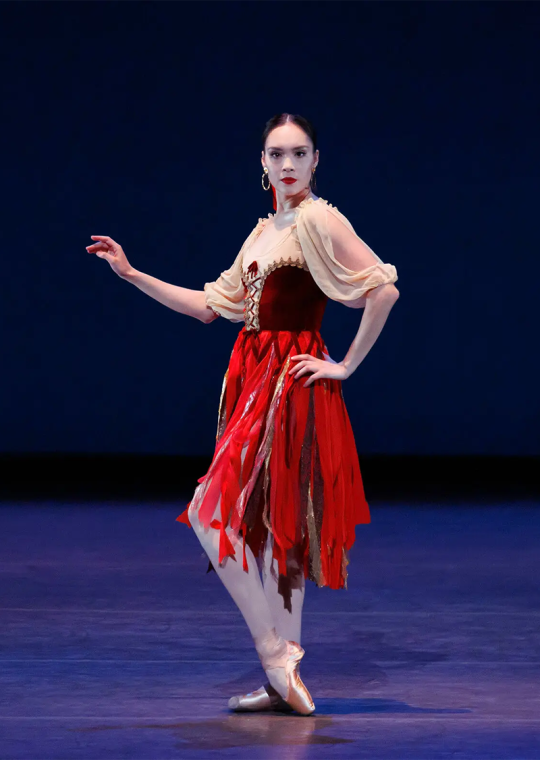
Above: Nadon in Errante. Photo: Erin Baiano via the NY Times
In Ratmansky’s “Pictures at an Exhibition,” Nadon was electric, fleshing out shapes while stretching bigger, deeper, longer—her arms are as fluid and expressive as her legs. And Nadon, at 5 foot 8 inches, has legs. Working with Ratmansky, who is City Ballet’s artist in residence, is sharpening her technique, she said, just as Tiler Peck did last season when Nadon danced in her ballet, “Concerto for Two Pianos.”
“He’s so funny," Nadon said of Ratmansky’s polite requests. “He’ll be like, ‘Do you think you could turn out the leg a little more?’ ‘Do you think you could hit fifth there?’ I’m like, ‘Yeah, I probably could.’”
This season, she performed in two of Tanowitz’s ballets: “Gustave Le Gray No. 1” and “Law of Mosaics,” which ends with Nadon dancing a solo barefoot. “She doesn’t dance at you, she draws the audience in, and that’s her power,” Tanowitz said. “It’s almost like she’s letting us in on this intimate part of herself.”
How many dancers can be understated and wild? It has much to do with how utterly at ease Nadon is onstage, which dates to her training at the Inland Pacific Ballet Academy in Montclair, Calif., where she had many opportunities to perform. “I think it was really beneficial growing up,” she said, “to not be scared onstage.” This was already apparent in 2017, when she danced the female lead in Balanchine’s “Scotch Symphony” at the School of American Ballet Workshop Performances, the annual year-end display of student talent. She was a fearless rush of power and delicacy that left audience members in disbelief. Recalling it now, Nadon laughed. “I didn’t think about it too much,” she said, “and just did the show and then everyone liked it, and I was like, Oh, I guess you’ve never seen me perform.”

Photo: Sabrina Santiago for The New York Times
Next month, Nadon will make her debut in “Diamonds,” the final section of “Jewels,” set to Tchaikovsky, at the Kennedy Center. “There’s something about the Tchaikovsky—the swells and the grandeur that you just feel in your soul,” she said. “I’m excited to live in that world and see how it feels.”
The part was made for Farrell, and dancing it speaks to Nadon’s future as an integral part of City Ballet. But getting to this point was far from a sure thing. Her father is a professor of government and her mother was a lawyer; neither knew much about ballet aside from the dramatic, dark side that is often shown in films.
When Nadon was accepted to the School of American Ballet, City Ballet’s training ground, she knew her parents weren’t going to want her to go, which would mean leaving home at a young age. She is grateful to Darci Kistler, a former City Ballet principal, who offered her a scholarship for the summer course and convinced her parents that it would be more than OK to let her go.
“Even getting my parents to agree to let me audition was a struggle,” Nadon said. “I was like, ‘I just want to see if I get in’ and they were like, ‘You’re not going to go, but you can audition just for yourself.’”
To Kistler, she said: “‘Oh—my parents aren’t going to let me, but thank you so much.’ And Darci said, ‘Can you go get your mom?’ I was, like, running through the hallways.”
It wasn’t a yes on the spot, but after some conversations, they agreed. “I’ll always be really grateful to her for putting in that extra effort,” Nadon said. “My parents still are, like, Thank God for Darci.”
Nadon’s path through the City Ballet ranks has been swift. She joined the corps de ballet in November 2018 and was promoted to soloist in 2022. Just a year later, she was named principal. “There was a lot of thought that went into—when you start pushing, giving the opportunities—making sure she was ready,” Whelan said. “We don’t want any dancer to fail. We don’t want to just throw them out there and say, let’s see what happens.”
But Nadon was ready—for all of it. “When I think of myself having the title of principal dancer, it does seem kind of crazy and foreign, but on the day to day, I’m just dancing my ballets and going out onstage,” she said with a cheerful shrug. “I guess I’ve tried not to overthink it too much because I think it could be very heavy and a lot of pressure.”
Nadon is self-aware. Her temperament, she realizes, is a blessing. She gets nervous for shows, but she’s never anxious. And she’s there to dance. “My favorite part of the job is just going out onstage and seeing what happens,” she said. “It’s almost like I’m surprised by what my body does. I’m finding out what’s going to happen at the same time as the audience.”
#Mira Nadon#New York City Ballet#NYCB#ballet#Balanchine#Suzanne Farrell#Darci Kistler#Alexei Ratmansky#Pam Tanowitz#ballerina
7 notes
·
View notes
Text
Danskin 1990
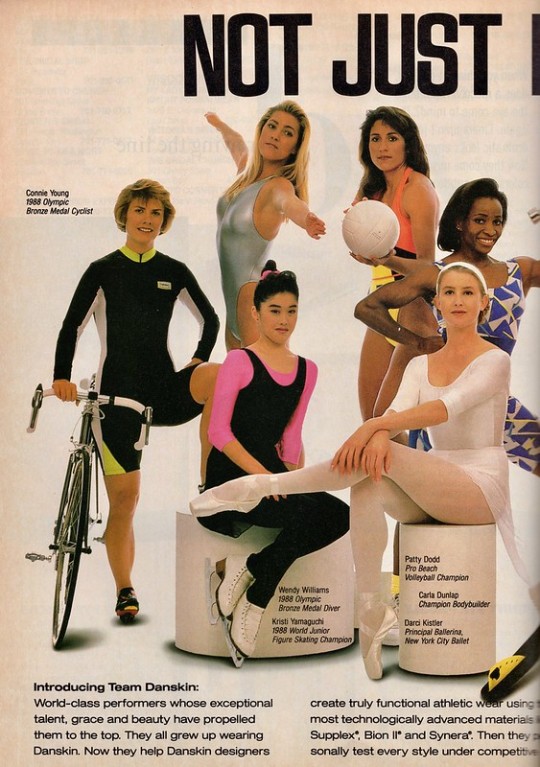

#connie young#wendy williams#kristi yamaguchi#patty dodd#carla dunlap#darci kistler#1990s#sports#american#fashion#kim alexis#shaun stafford#ramona#brandy johnson#camille duvall#celebrities
8 notes
·
View notes
Note
Are there any dancers in particular who inspired Annabeth or Percy? Or any of the others?
Good question! Yes, but also eeehhh
Obviously, they have their big inspirations. But I don't have a backlog of OCs who are past generations of dancers that have inspired them. The exceptions are Lupa and Chiron. Very probably, Lupa has been an inspiration to Annabeth and someone she's looked up to. Never meet your heroes I guess.
Percy's major inspiration is Edward Villella, who was mentioned in the "Tarantella" chapter. Villella is a real dancer, and is the founder of Miami City Ballet.
I think one of Annabeth's favorite dancers would be Marianela Nuñez, who is at the Royal Ballet.
But I really hesitate to name real dancers, particularly past NYCB dancers, because I don't want to imply their existence in the world of the story. I don't want this to be NYCB rpf, nor do I think people want that. Realistically, dancers like Wendy Whelan and Darci Kistler would be huge inspirations for Annabeth, but they both still work with NYCB/SAB, so if they existed in the story, Annabeth would probably know them personally.
2 notes
·
View notes
Text
darci kistler sugar plum fairy of all time
0 notes
Photo

darci kistler as the sugarplum fairy and jessica lynn cohen as marie stahlbaum in “the nutcracker” (1993), dir. emile ardolino .
#film#90s#nostalgia#ballet#the nutcracker#darci kistler#the sugarplum fairy#marie stahlbaum#jessica lynn cohen#emile ardolino#and this one because the fairy was the literal blueprint to five year old me<3
249 notes
·
View notes
Photo
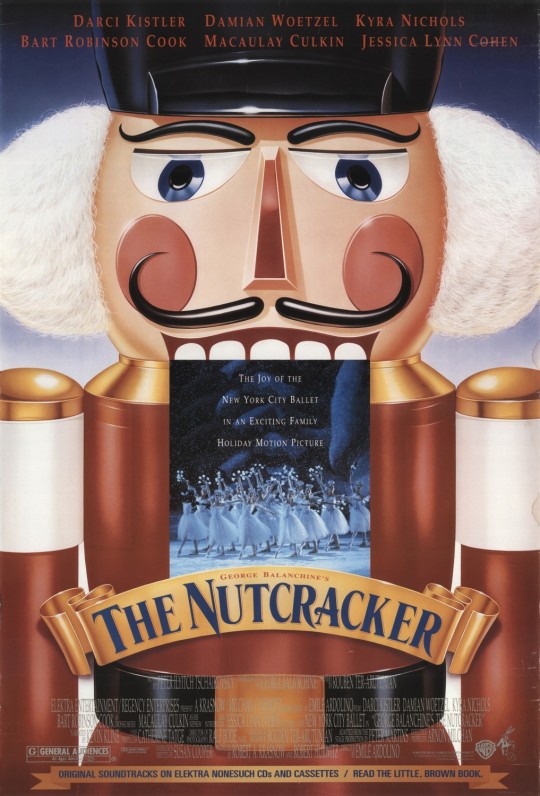
#the nutcracker#darci kistler#damian woetzel#kyra nichols#bart robinson cook#macaulay culkin#jessica lynn cohen#new york city ballet#kevin kline#emile ardolino#1993
2 notes
·
View notes
Photo

darci, maria, and wendy: dream team
#nycb#new york city ballet#nycballet#nyc ballet#ballet#ballerina#ballerinas#pointe#dancer#dance#dancers#darci kistler#maria kowroski#wendy whelan#jewels#balanchine#nycballerinas#nycb ballerinas#nycb ballerina#george balanchine#balanchine ballerina#balanchine ballet#balanchine ballets#balanchine ballerinas
6 notes
·
View notes
Photo






Darci Kistler and Damian Woetzel in costume for The Nutcracker (NYCB, 1992)
106 notes
·
View notes
Text
George Balanchine's Der Nussknacker
George Balanchine’s Der Nussknacker
Story:Das kleine Mädchen Marie bekommt an einem verschneiten Weihnachtsabend ein ganz besonderes Geschenk von ihrem Onkel Herr Drosselmeier. Er schenkt ihr einen Nussknacker aus Holz. Wie durch Zauberhand erwacht die Holzfigur in der darauffolgenden Nacht zum Leben. So steht plötzlich ein Junge vor Marie. Den beiden Kindern steht eine abenteuerreiche Nacht voller Musik, Tanz und jeder Menge Spaß…
View On WordPress
#1993#Abenteuer#Ballett#Bart Robinson Cook#Damian Woetzel#Darci Kistler#Drosselmeier#E. T. A. Hoffmann#Emile Ardolino#Fantasy#George Balanchine#Home Alone#Jessica Lynn Cohen#Kevin allein zu Hause#Kunstmärchen#Macaulay Culkin#Musikfilm#New York City Ballett#Nussknacker#Nussknacker und Mäusekönig#Peter Ilyitich Tschaikovsky#Ralf D. Bode#Robert A. Krasnow#Robert Hurwitz#Susan Cooper
1 note
·
View note
Photo

Nikolaj Hubbe and Darci Kistler in Apollo.
2 notes
·
View notes
Text
The Nutcracker: A NY-Born American Institution
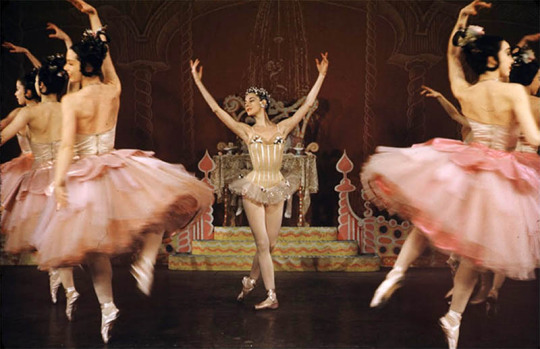
Above: Tanaquil Le Clerq leading the Waltz of the Flowers in Act II. She was the original Dew Drop.
The Nutcracker is so much a part of Christmas that it’s easy to assume that it’s always been this way. In fact, Nutcracker as a holiday treat dates back only to 1954, and the New York City Ballet.
It was not the first American Nutcracker. William Christensen’s production for the San Francisco Ballet, staged ten years earlier, has that distinction. But that production didn’t lead to a thousand copycat productions of one sort or another, likely because the United States had few ballet companies in those days and, of course, it wasn’t in New York. The suite of music, drawn mostly from the second act of the ballet, was well known, but its context was not.
In the early 1950s, NYCB was still a very young company (it had been founded in 1948) and its home was the New York City Center, a city-owned theater (it moved in 1965 to the Philip Johnson-designed New York State Theater in Lincoln Center). The work of George Balanchine, founding choreographer and ballet master in chief of NYCB, was cutting-edged and appealed mostly to the culturati. Morton Baum, president of the City Center, was always after the company to stage ballets that would draw crowds. Balanchine had already mounted his own versions of Firebird and the second act of Swan Lake, but Baum thought they needed an evening-long production.
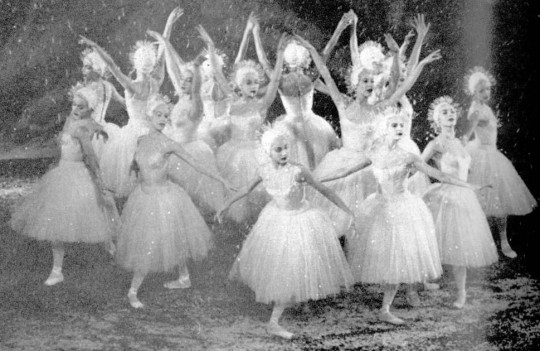
Above: The Snowflake Waltz at the end of Act I. Photo of 1954 original production.
Balanchine thought of The Nutcracker, a ballet in which he, first as a student and then as a dancer in the Imperial Ballet in St. Petersburg, had danced several roles, including the Nutcracker Prince and Candy Cane (Trepak or Russian Dance). With NYCB, he occasionally appeared as Herr Drosselmeyer, the mysterious man who gives Clara the nutcracker doll. He choreographed it all except for the battle between the Nutcracker and the Mouse King, which was done by Jerome Robbins, the Candy Cane divertissement, which is the original Alexander Shiryaev choreography from the ballet’s premiere in 1892, and the prince’s mime speech in the second act, which also came from the original production.
It was by far NYCB’s most ambitious production to date. In addition to a large cast of company members, there were two alternating casts of 39 children from the NYCB-affiliated School of American Ballet (they now number 64), a Christmas tree that grew to gigantic proportions, and a blizzard—in addition to mountains of costumes and several sets. The costume for Mother Ginger alone is now 9 feet wide and weighs 85 pounds.
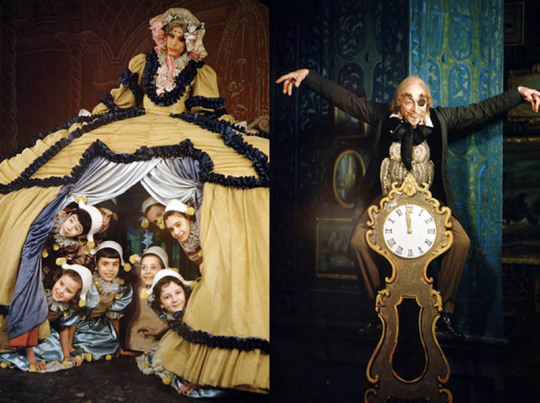
Above left: Edward Bigelow as Mother Ginger. Right: Michael Arshansky as Drosselmeyer. Photos of original production.
Balanchine’s production is one “by, for, and about” children. It makes no attempt to darken the ballet’s story by suggesting that Drosselmeyer has wicked designs on Clara, as some modern productions have done.
It opened on February 2, 1954. Baum wanted the company to perform in December, when theater attendance was light, so they put it on again later in the year and were rewarded by sold-out houses and a demand for more performances. Since then, NYCB has danced it for five weeks, from Thanksgiving to New Year’s, 8 or 9 performances a week, with double casts of both adults and children and numerous opportunities for soloists and apprentices.
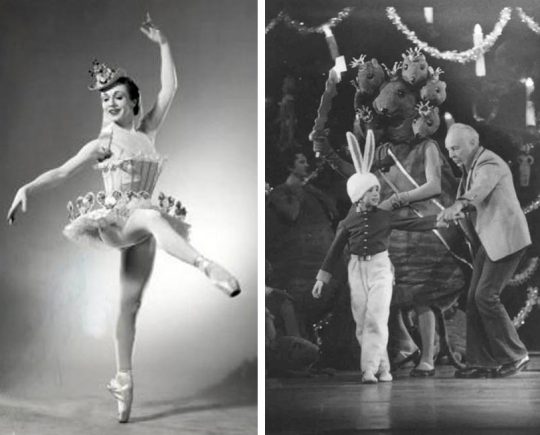
Above left: Janet Reed as lead Marzipan Shepherdess. Right: Balanchine rehearsing a child dancer playing the Bunny and an adult dancer playing the Mouse King.
It quickly became a financial bedrock for the company, as it has for ballet companies all over the country, both professional and amateur, who were quick to adopt it as a holiday treat. In New York state alone, one list has 32 productions in addition to NYCB’s.In some cases it accounts for fully half of a company’s revenue over the season. Many companies, including Miami City Ballet, Pacific Northwest Ballet, Oregon Ballet Theater, and the Pennsylvania Ballet, dance Balanchine’s version. Others, some too small or insufficiently high-powered, dance alternate versions with the number of adult soloists reduced. Many import stars from NYCB and American Ballet Theater to dance Sugar Plum and her cavalier.
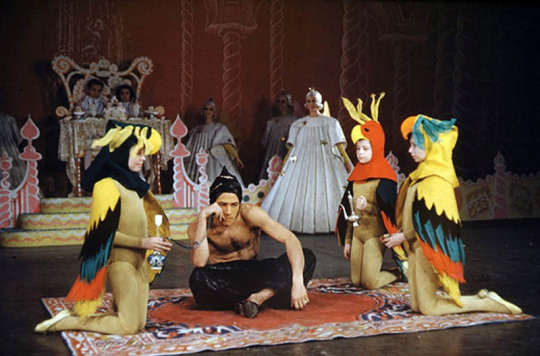
Above: Francisco Moncion, the original Coffee (Arabian Dance). This divertissement is now danced by a woman.
Over the years, many of the ballet’s child performers have gone onto professional careers. At NYCB, Zina Bethune and Bonnie Bedelia, both former Claras, became well-known actresses; Eliot Feld (Nutcracker Prince) turned into a noted choreographer; Peter Boal (also Nutcracker Prince) became director of the Pacific Northwest Ballet in Seattle; and at least 4 former Claras grew up to join the company. Two of them, Judith Fugate and Jennie Somogyi, eventually became principal dancers and danced the role of Sugar Plum Fairy.
NYCB has recorded the complete ballet twice, once in 1993 with Darci Kistler, Damian Woetzel, and Kyra Nichols, and again in 2011, with Megan Fairchild, Joaquin de Luz, and Ashley Bouder. Both recordings are available on disc.
Links What NYCB principal Abi Stafford learned dancing 48 Nutcrackers How Balanchine’s version compares to that of a company performing a version based on the Russian original NYCB’s first black Clara (now called Marie after the Russian original) My First Nutcracker: Eight NYCB dancers recall their first experience with Nutcracker Balanchine’s Christmas miracle. Includes comments from NYCB dancers Behind the scenes at NYCB’s Nutcracker (photo album) Nutcracker Nation, a book about how the ballet became an American institution
168 notes
·
View notes
Note
oh I initially meant dancers who inspired YOU when writing Percy/Annabeth or who they were partially based on but honestly love the question you answered!!
Oh! Sorry! I totally misread that lmao!
Honestly, there are so many. Ballet is one of my special interests, even before writing this story, so I've seen so many videos, interviews, documentaries etc of dancers, and I've just collected their stories in my mind. No one is a single one-to-one representation of any one dancer or their story.
A lot of my information on SAB and NYCB comes from Kathryn Morgan's YouTube channel, and stories like the Romeo and Juliet drop are hers. I do usually try to contextualize and reimagine stories so that they aren't just stolen, but the Romeo and Juliet drop was one that was fully lifted. KM also did Romeo and Juliet very young, much like Annabeth.
Drawing on dance styles was the most fun for me, because I got to just watch a bunch of dancing and figure out what did I want to give to which dancer, particularly Annabeth. I wanted Annabeth to be distinct at NYCB, but still renowned. I also wanted her to not always be a perfect dance match for Percy, so I knew I wanted her to be considered a slower, more classical dancer among these Balachine dancers.
Annabeth is really an amalgamation of several dancers', particularly in terms of how I imagine her style' styles: Kathryn Morgan, Sara Mearns, Marianella Nunez, and Tiler Peck. They are the dancers I find myself referring back to the most when writing her dancing. Peck has this incredible technical precision and speed that I think Annabeth will really start to be recognized for post-Beauty. Prior to Beauty, she was probably on a lot of "up and coming" dancer lists, and was consider a career to watch, a young dancer with a lot of promise. And then there was a lot of anxiety and concern when she disappeared. But then she comes back really better than ever, and with a technical precision she didn't quite have when she was younger. But I don't think she's exactly like Peck. I really see Morgan and Mearns as Balanchine-trained dancers who have a real soft quality to their dancing; there isn't the sharp precision of Peck, but that's not a flaw. It's their aesthetic approach. (I also sometimes fine Peck a little too smiley). I really admire Morgan's and Mearns's acting abilities, particularly in full-length ballets. And then Nuńez is just an icon. I think Annabeth in her 30s, when she's doing her best dancing, is going to have that total Nuńez world-renowned star quality.
Percy doesn't have as many inspirations. I like watching the girls. But Villella is the big one. I saw that Tarantella video years ago before this story even existed in my mind, and thought "if Percy were a dancer, he'd be that dancer." Misty Copeland of ABT is a dancer who I knew started very young, so she was part of that inspiration as well.
I also draw on Peck for Piper a bit -- I think Piper is a really quick, sharp dancer who can just turn like a top. Ashley Bouder is another one.
Reyna in my head is a bit like Osipova: technically perfect, incredibly strong and flexible, and when she jumps she stays in the air for about an hour and a half before landing.
Also -- I describe Lupa as Balanchine's last muse, and in one of my tumblr prompts I think I also revealed she was taken into the company at 16 as well, and that story is just fully Darci Kistler's. I didn't take anything else from Darci's life or her personality to create Lupa.
0 notes
Text
George Balanchine's The Nutcracker
George Balanchine’s The Nutcracker
George Balanchine’s The Nutcracker, starring Kevin Kline, Macaulay Culkin, Jessica Lynn Cohen, Bart Robinson Cook, Darci Kistler Synopsis of George Balanchine’s The Nutcracker Angels and sugarplums. Candy canes and ice. A magic prince, a dreamy young girl, a mysterious old man and a Christmas tree that grows sky high. Enter the world of George Balanchine’s The Nutcracker, featuring the New York…
View On WordPress
#Bart Robinson Cook#Christmas#Darci Kistler#Jessica Lynn Cohen#Kevin Kline#Macaulay Culkin#The Nutcracker
0 notes
Video
youtube
Juliet's Room, Part 2 with Commentary | Kathryn Morgan
This is more of Act 2 of Romeo and Juliet with ballet commentary. We continue on with Juliet's room, Friar Lawrence, and the scene where she drinks the potion. I hope I have given you insights, technique tips, and humor along the way! The cast includes Jonathon Stafford, Jock Soto, Darci Kistler, and Adrian Danchig-Waring.
6 notes
·
View notes
Photo

Darci Kistler and Damian Woetzel in The Nutcracker (NYCB, 1992)
47 notes
·
View notes
Note
Yes for contemporary /jazz/tap/ lyrical /open styles and had darci Kistler as my ballet teacher for most of my years 💕
Was Mandy Rogers trained to dance by her Mom?
@mandyrogersjpd
5 notes
·
View notes